| Columns Retired Columns & Blogs |
I was wondering whether the port could be plugged, and what sort of effect this would have on measured and perceived response?
I used DRA Labs' MLSSA system and a calibrated DPA 4006 microphone to measure the Totem Dreamcatcher's frequency response in the farfield. For the nearfield response, I used an Earthworks QTC-40, which has a ¼" capsule and therefore won't appreciably change the tuning of the small-diameter port. Despite its small size, the Dreamcatcher's sensitivity was average, at an estimated 87.5dB(B)/2.83V/m, which conforms with the specification. Its impedance (fig.1) remains above 6 ohms for most of the audioband but does drop to 3.8 ohms in the lower midrange. The combination of 5 ohms and –38° electrical phase angle at 170Hz will make a good 4 ohm–rated amplifier optimal for use with this speaker.
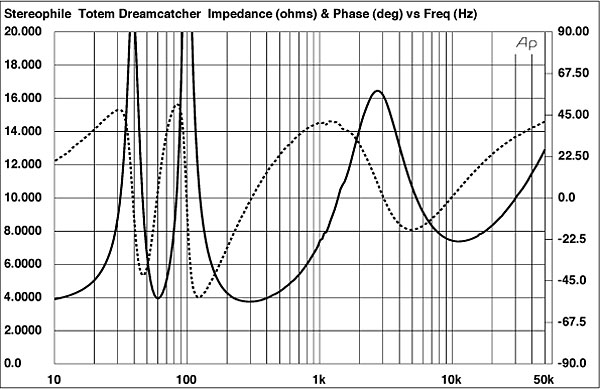
Fig.1 Totem Dreamcatcher, electrical impedance (solid) and phase (dashed). (2 ohms/vertical div.)
Bob Reina noted that he could detect no cabinet vibrational resonances, and the impedance traces below 1kHz are free from the small wrinkles that would indicate the presence of such resonances. Even so, examining the behavior of the undamped cabinet walls with an accelerometer revealed strong modes at 613 and 1100Hz (fig.2); these were present on all surfaces. There is a slight discontinuity in the impedance traces at this frequency, as well as another at 1500Hz, and as I was taking this measurement I could hear a whistle-like character to the sound of the MLS noise. These modes therefore appear to be not vibrational modes as such, but strong acoustic pipe resonances in the deep, narrow port.
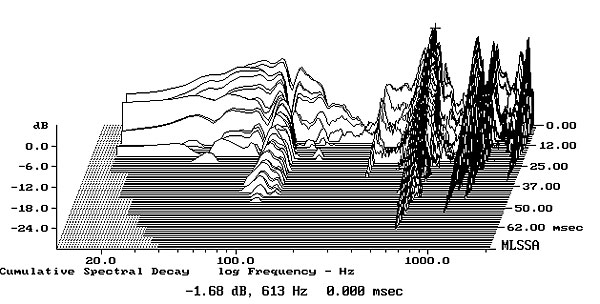
Fig.2 Totem Dreamcatcher, cumulative spectral-decay plot calculated from output of accelerometer fastened to center of top panel (MLS driving voltage to speaker, 7.55V; measurement bandwidth, 2kHz).
This was confirmed by measuring the port's output in the nearfield (fig.3, red trace), where the upper-frequency modes are higher than the port's output in its tuning region, and even give rise to a small peak in the Dreamcatcher's farfield output. I dismantled one of the speakers and saw that the inner opening of the port almost touches the tweeter magnet. I conjecture that this restricted access means that the circular edge of the port acts like an edge-blown flute mouthpiece. However, these resonances are of very high Q (Quality Factor), so may not be as audible as suggested by this graph. (The higher its Q, the longer a resonance needs to be stimulated with energy at the same frequency for it fully to develop.)
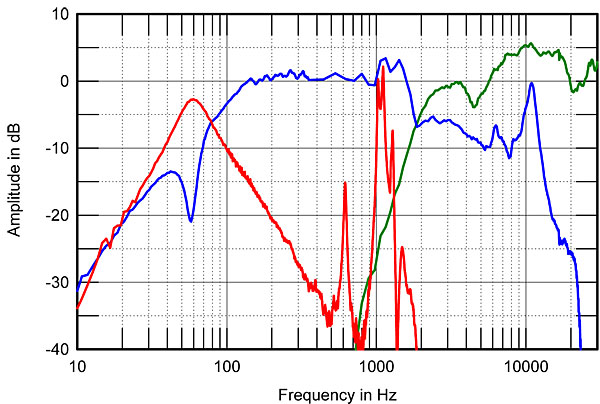
Fig.3 Totem Dreamcatcher, acoustic crossover on tweeter axis at 50", corrected for microphone response, with nearfield woofer (blue), and port (red) responses plotted below 300Hz and 2kHz, respectively.
Other than that problem, the port is tuned in classic manner to 57Hz, slightly lower in frequency than the minimum in the impedance-magnitude plot (fig.1, solid trace), with a well-behaved bandpass nature and a corresponding, well-defined notch in the woofer's response at the same frequency (fig.3, blue trace). The speaker offers a flat midrange, but the use of a first-order crossover—a single air-cored inductor is in series with the drive-unit—means that the woofer's output extends throughout the treble, with a strong peak evident at 12kHz. The tweeter is fed via a single 4.1µF plastic-film capacitor and, as Bob noted in his auditioning, the highs are a little elevated.
However, other than the port resonant problems and the elevated top octaves, the speaker actually has quite a flat balance, with a low-frequency response that reaches down to 60Hz or so (fig.4). But when Bob wrote that "the degree of resolution in the midrange let me listen deeply into each recording to uncover an extraordinary amount of detail," I do wonder if he was responding, not only to the flat tonal balance but also to the speaker's resonant problems emphasizing recorded detail.
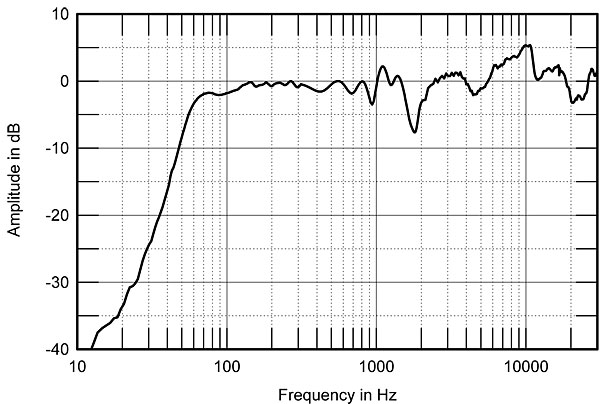
Fig.4 Totem Dreamcatcher, anechoic response on tweeter axis at 50", averaged across 30° horizontal window and corrected for microphone response, with complex sum of nearfield woofer and port responses plotted below 300Hz.
To investigate this behavior further, I set up the pair of Dreamcatchers in my own room, sitting them on 24" Celestion stands and driving them with Musical Fidelity's AMS-100 class-A amplifier. They were positioned where minimonitors have always sounded at their best in my room, each about 27" from the nearest sidewalls (measured from the woofer) and well in front of the wall behind it.
Though the overall presentation was light in weight, the highs were clean and open-sounding. There was also enough upper-bass energy present on bass guitar to balance the highs. Double-bass did sound a little gruff, however. Listening to the 1/3-octave warble tones on Editor's Choice (CD, Stereophile STPH016-2), I could hear a respectable amount of low-frequency energy down to the 50Hz band. The imaging was well-defined, if not quite up to the standard set by the 33 year-old pair of BBC LS3/5as that I had been using for the prior week, and the soundstage spacious. Though the port's resonant problems could be heard at the listening position with pink noise from my Editor's Choice CD , I must admit that it was considerably more difficult to hear them consistently with music.
However, the more I listened, and more importantly, as I listened to a wide range of different kinds of music, I became aware of a degree of congestion in the upper midrange and a slightly nasal coloration. Both characteristics were apparent with solo piano recordings. With my recording of Robert Schumann's Symphonic Études, which is scheduled for release in the fall, piano notes in the region of the upper-frequency port resonances were accentuated, jumping forward a little in the soundstage. Richard Lehnert's speaking voice on Editor's Choice also revealed the nasal coloration.
The red trace in fig.5 shows the spatially averaged, 1/6-octave response of the Dreamcatchers in my listening room. The lows extend to 60Hz, helped a little bit by a resonant mode in my room, with a smooth rise throughout the midrange. A peak is evident at 1100Hz, with then a lack of energy centered on 2kHz. In my experience, this kind of response shape correlates well with perceived nasality. The mid- and high-treble regions are impressively flat almost up to 20kHz, though with an in-room response, the increasing absorptivity of the room furnishings means that a flat response extending this high in frequency implies a little too much energy in the top two octaves.
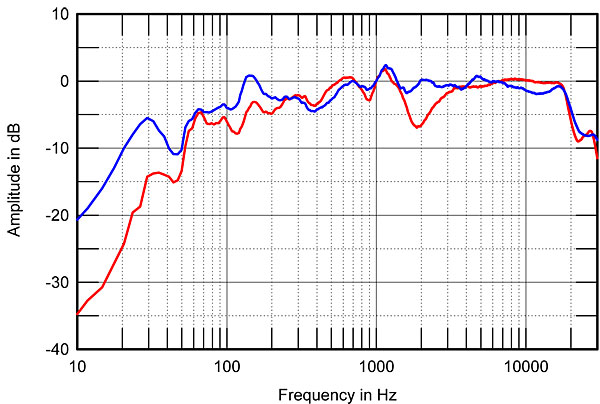
Fig.5 Totem Dreamcatcher, spatially averaged, 1/6-octave response in JA's listening room (red) and of BBC LS3/5a (blue).
For reference, the blue trace in fig.5 shows the spatially averaged response in my room of the BBC LS3/5a. The underdamped, sealed-box woofer alignment of the English speaker results both in more upper-bass energy in-room and in lows that roll-off less than those of the ported Totem. The LS3/5a has a similar peak in its response between 1000Hz and 1500Hz—this also gives rise to a touch of nasal coloration—but overall, its low treble is flatter than that of the Dreamcatcher. Though the LS3/5a has less energy in-room in the top two audio octaves than the Totem speaker, its treble is still a little too hot for accuracy.
Returning to the Dreamcatcher, its lateral dispersion (fig.6) is wide and even, as would be expected from its narrow baffle and small-diameter woofer, though the tweeter becomes a little more directional in its top octaves than I anticipated. In-room, this will tend to balance the on-axis excess in the same region. The on-axis peak at 1100Hz also rolls off to the speaker's sides, which is why a notch appears at this frequency in this graph, which is normalized to the on-axis response. In the vertical plane (fig.7), a suckout develops quite quickly as you move below the tweeter axis, suggesting that low stands will work better than high ones. The 24" stands that both Bob and I used will have been about right.
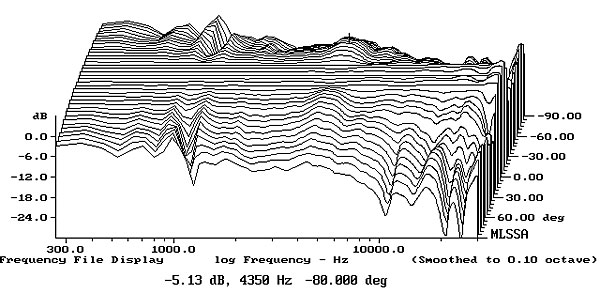
Fig.6 Totem Dreamcatcher, lateral response family at 50", normalized to response on tweeter axis, from back to front: differences in response 90–5° off axis, reference response, differences in response 5–90° off axis.
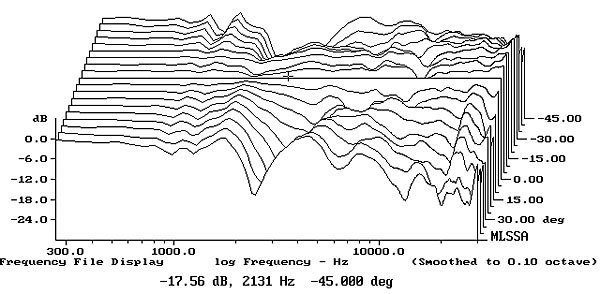
Fig.7 Totem Dreamcatcher, vertical response family at 50", normalized to response on tweeter axis, from back to front: differences in response 45–5° above axis, reference response, differences in response 5–45° below axis.
In the time domain, the Dreamcatcher's step response on its tweeter axis (fig.8) suggests that the tweeter is connected in inverted acoustic polarity, the woofer in positive polarity. This was confirmed by the individual step responses of the two drive-units in fig.9, where it can also be seen that the decay of the tweeter's step blends smoothly with the start of the woofer's, suggesting optimal crossover design. The tail of the woofer's step, however, is broken by ringing with a period of just under 1ms. The Totem's cumulative spectral-decay plot on the tweeter axis (fig.10) shows that there is indeed a ridge of delayed energy at 1110Hz, and another at 1420Hz. There is also a ridge of delayed energy at 10.7kHz, which emanates from the woofer.
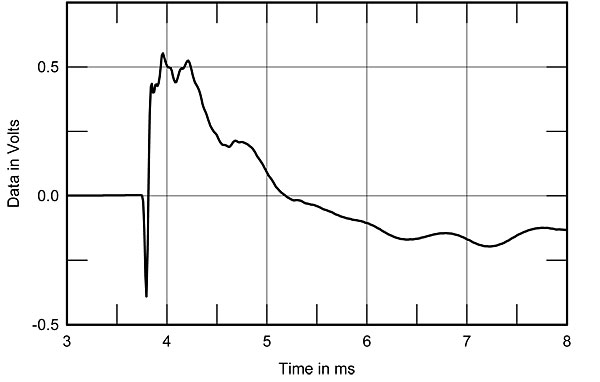
Fig.8 Totem Dreamcatcher, step response on tweeter axis at 50" (5ms time window, 30kHz bandwidth).
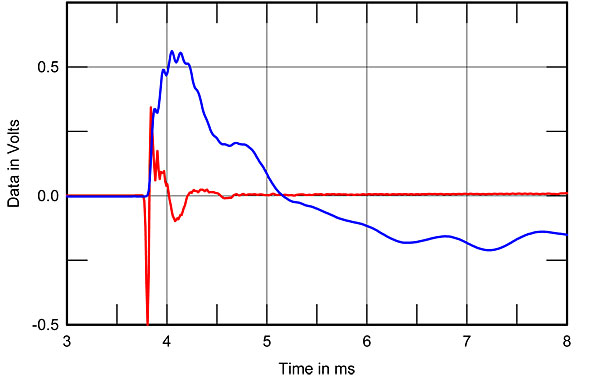
Fig.9 Totem Dreamcatcher, step responses of tweeter (red) and woofer (blue) on tweeter axis at 50" (5ms time window, 30kHz bandwidth).
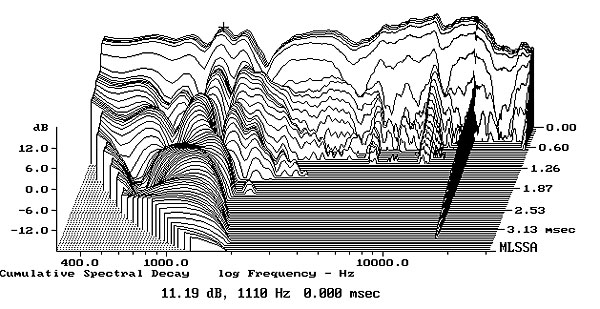
Fig.10 Totem Dreamcatcher, cumulative spectral-decay plot on tweeter axis at 50" (0.15ms risetime).
Bob Reina says that "The Dreamcatcher has been one of the most difficult speakers I've reviewed, with a sound very different from that of any other affordable speaker I've heard." I believe the Totem's measured performance reveals why it sounds different, but not why he liked that sound as much as he did. Yes, the Dreamcatcher is a very affordable loudspeaker, and it does have a flat midrange, an open-sounding and spacious presentation, and respectable low-frequencies for such a small speaker. Nevertheless, I was disappointed by its measured performance.—John Atkinson

I was wondering whether the port could be plugged, and what sort of effect this would have on measured and perceived response?

Bob,
I have two questions:
1) Are your favourable subjective assessments of the Dreamcatcher's altered at all by the less than ideal measurements? This seems like a case where measurements don't tell the entire story and subsequently don't guarantee sound quality. Agree? Disagree?
2) I'm curious about your thoughts regarding matching the Simaudio Moon i.5 with the Dreamcatcher's in a small to medium sized room, most likely as a smaller bedroom system? I do recognize that you have not reviewed the i.5, however, you did recently review the Simaudio i-1. knowing Simaudio, my assumption would be that many of the positive characteristics of the i-1 would carry-over to i.5. Additionally, your positive feelings towards the i-1 seem to parallel the Creek Destiny, with which you used when reviewing the Dreamcatcher's.
Cheers

I have to agree with Mr. Reina on this. These speakers sound is indeed intoxicating. It is involving, refined, fast, detailed but most of all it is just musical. I'm breakin-in a pair of dreamcatchers. Right out of the box they sound amazing. They image like crazy! Can't stop listening. I'm running mine with a Marantz PM6004/CD6004, and found it to be powerful enough for them. One thing I noticed is that the woofer is different than the ones in the pictures in this website. Mine have a plug in the woofer. Fantastic speakers! Forget measurements! Just listen!